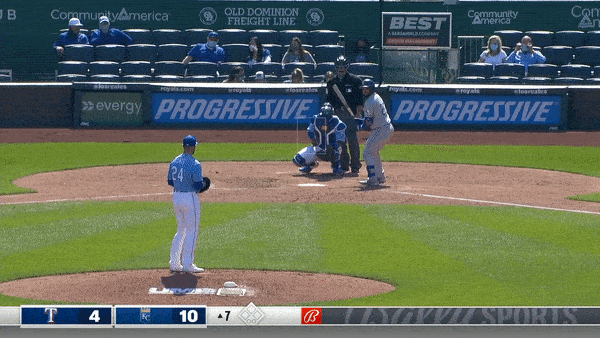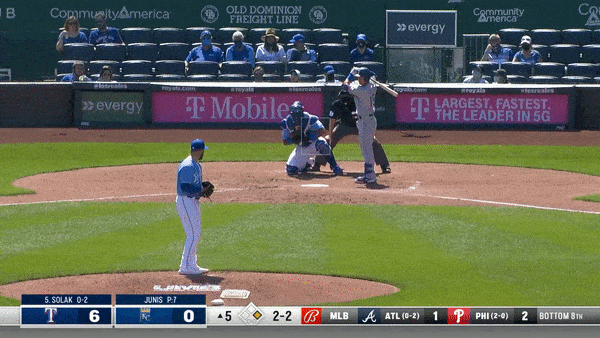Junis and his new cutter
We've seen glimpses of the pitch in limited action. It should be on full display on Wednesday afternoon against Cleveland.

With Brad Keller pushed back a day in the Royals’ rotation, that opens an early opportunity for a fifth starter. Come on down, Jakob Junis!
As you’ve certainly heard by now, Junis spend the winter working with his brother and refining a new cut fastball. He debuted the pitch in spring and had an exceptional run in the Cactus League. In the span of a few months, he’s gone from probable generic bullpen arm to intriguing possibility for the rotation.
The Royals are going to need to mix and match to get the maximum number of innings from their rotation this year and if Junis can fill a role, it makes the management of the starting five a little less stressful.
Welcome to the cutter
Junis and his 2021 pitch profile
I’m going to do something perhaps a bit unwise, but let’s wade into the small sample size that is Junis’s 2021. He’s thrown just 30 pitches in two outings. Here’s the breakdown so far.
4-Seam Fastball - 60%
Cutter - 23.3%
Slider - 13.3%
Sinker - 3.3%
Because this represents 30 pitches, this is in no way predictive of future pitch usage. His 4-seam percentage will drop and his secondary pitch percentages will almost all certainly increase. Let’s do something a little more useful and expand the pitch usage to include velocity and spin rate we’ve seen in both his 2021 outings. (Excluding the sinker because he’s thrown only one of those.)
For context, let’s look at how he’s thrown his four-seamer and slider the last several years.
The interesting thing about the above table is how his slider, in just a handful of pitches this year, is consistent with past velocity and spin rate. The fastball velocity is likewise consistent. (Although that could come as a bit of a surprise considering he’s pitching out of the bullpen. You would figure Junis could come into something of a velo bump that we see happen when a starter moves to the bullpen. It hasn’t happened so far.)
What has changed on his fastball is an increase in spin rate.
The more spin gives the fastball more of a “rise.” The more rise and more bats will miss. Junis’s spin rate on the fastball so far has moved from below average to above average, but he still lacks the velocity/spin combo to make the pitch elite. (This is something to watch going forward. He has a 20 percent whiff rate on his fastball currently, up from his usual 15 percent.)
How to identify the Junis cutter
The wrinkle in this profile is Junis’s addition of a cutter to his arsenal. It’s a pitch that could elevate him from swingman to a key contributor in the rotation.
Velocity-wise, the cutter lives between the fastballs and the slider, giving him another gear for hitters to anticipate. For the pitch to live almost exactly between the four-seamer and slider is a little unique as for most pitchers it’s closer to the fastball. Just another wrinkle that figures to make the Junis cutter effective.
Spin-wise, it will resemble the slider. It also features close to the same horizontal break and vertical drop. When it comes to movement, Junis cutter moves less than the slider but more than the fastball, as you would expect. Unlike the velocity where the pitch is mostly in the middle of the other two, the cutter has some similar break and drop to the slider.
Again, the small sample caveat applies (it’s only four pitches for crying out loud!) but the movement on his slider is consistent from year to year. If the trend holds, it may continue increased horizontal movement.
So we’re talking about a pitch on the Junis slider that has on average around 44 inches of drop and 15-16 inches of break. Imagine standing in the box, picking up the pitch with the spin and your brain triggering “slider.” This is what you would expect.
The slider has long been Junis’s best pitch. According to Baseball Savant, its vertical movement is average, but the horizontal movement is exceptional, better than double the amount of the average break.
What happens when you’re clicking on slider and you see this?
It’s a similar pitch to the slider but about 4 mph faster and with slightly less movement on both the horizontal and vertical plane. It’s coming in faster and moving less, you can hardly blame the hitter for getting an extreme case of the vapors and having his bat just suddenly become inert.
Junis hasn’t exactly been pleased with the pitch thus far, telling Anne Rogers at MLB.com:
“The shape of it is different compared to how it was in Arizona for the last few outings, just adjusting to the extra adrenaline that comes with being in a real game with fans and stuff. Trying to lock that true cutter shape—it’s coming with time. It hasn’t been what I wanted the first couple outings, but it’s been good enough. Gotten the job done, stayed off of barrels. I know it could be better, so that’s been promising as well.”
Understandable the change in actual environment that comes with moving out of the desert in Arizona along with regular season adrenaline would affect the pitch. And it’s new enough that Junis is still getting the proper feel for using it in a game. A start as an “opener” is probably an ideal time for him to continue to work on finding comfort with the cutter.
What to expect
Junis is in no way stretched out. He’s thrown just two innings in the Royals’ first two games and last went multiple frames when he tossed two innings exactly two weeks ago in Arizona. I would guess he’s good for one time through the lineup. Maybe three innings if he can keep runners off the bases.
Junis will face 2020 AL Cy Young award winner Shane Bieber. A tall order for the Royals bats.
The bet here is Carlos Hernández will back Junis out of the bullpen.
Still, this is a great time to unleash the cutter to see how it performs in concert with the four-seamer and slider while in the rotation. We’ve seen from the first series at home, the starting pitching isn’t a sure thing in Kansas City. Having Junis with a plus-cutter in the mix would certainly be a weapon.
Other notes
It will be interesting to see if Hunter Dozier makes his return to the lineup. He was taking batting practice in Cleveland and is reportedly feeling ready to get back on the field.
After the two games in Cleveland, the Royals head east to Chicago to again play the villain in another home opener for a team. Afternoon game on Thursday followed by another off day on Friday. It will be nice once the Royals move past this stretch and can get into the proper rhythm of the regular season.
Although these day games are kind of nice. From a selfish standpoint, it’s a little extra time to compile the newsletter. And a great opportunity to check out other games in the evening.
Random nonsense
The Royals are 3-1 for the first time to start a season since 2016.
With dingers in each of the first four games, it’s the second-longest home run streak to open a season. The record is seven games, set in 2015.










I have always been a Junis fan. His slider is ridiculous. Glad he has increase his FB spin rate and added the cutter. I hope this keeps him in the starting rotation long term. We can't have enough starting pitchers.